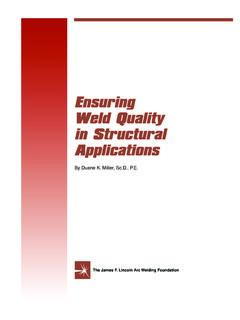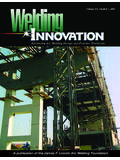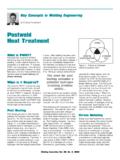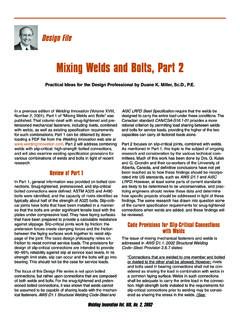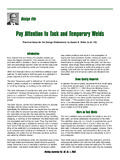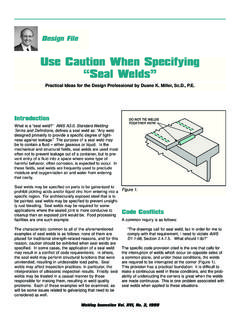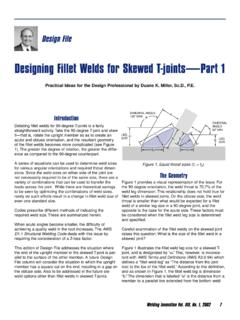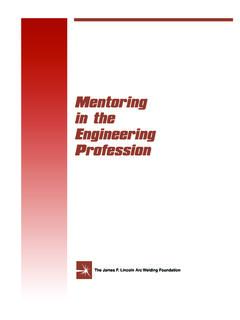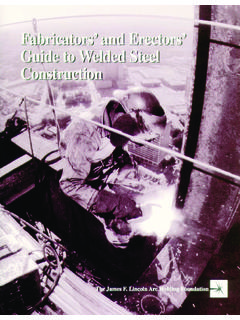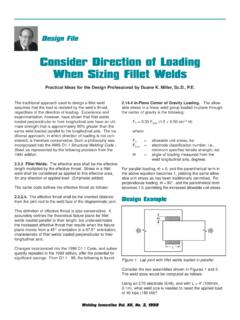Transcription of Use Undermatching Weld Metal Where Advantageous
1 Welding Innovation Vol. XIV, No. 1, 1997 How Strong Does a weld Have To Be? The answer is fairly simple: strong enough to transfer theloads that are passed between the two interconnectedmaterials. How strong does the weld Metal have to be?The answer to that question is far more order to make a weld of sufficient size, the designer hasthree variables that can be changed to affect the weldstrength: weld length, weld throat, and weld Metal three variables are involved, there are many combi-nations that are suitable for obtaining the correct weldstrength. It may be necessary to also consider the loadsimposed on the base Metal to ensure that the completewelded joint has sufficient strength. This edition of Design File will focus on the variable of weld purposes of this discussion, weld Metal strength isdefined as the yield and tensile strength of the depositedweld Metal , as measured by an all- weld Metal tensilecoupon extracted from a welded joint made in conformancewith the applicable AWS filler Metal specification.
2 Matching weld Metal has minimum specified yield andtensile strengths equal to or higher than the minimumspecified strength properties of the base Metal . Notice thatthe emphasis is placed on minimum specified propertiesbecause, in the case of both the filler Metal and the basemetal, the actual properties are routinely higher. An exam-ple of matching weld Metal would be the use of E70 XXfiller Metal on A572 grade 50 steel. The weld Metal /basemetal properties for this combination would be 60/50 ksiUse Undermatching weld Metal Where Advantageous (414/345 MPa) yield strength and 75/65 ksi (517/448 MPa)tensile strength. Even though the weld Metal has slightlyhigher properties than the base Metal , this is considered tobe a matching too often, engineers see filler Metal recommendationsprovided in codes that reference matching combinationsfor various grades of steel and assume that this is the onlyoption available.
3 While this will never generate a noncon-servative answer, it may eliminate better choices. Matchingfiller Metal tables were designed to give the recommenda-tions for one unique situation Where matching weld Metal isrequired, that is, Complete Joint Penetration (CJP) groovewelds in tension applications. All other applications permitsome degree of Undermatching , and Undermatching maybe a very desirable, cost-effective alternative for applica-tions such as Partial Joint Penetration (PJP) groove weldsand fillet significance of weld Metal strength, as compared tobase Metal strength, has increased in recent years, as thenumber of higher strength steels continues to grow. WhenA36 was the predominant steel, commercially availablefiller metals would routinely overmatch the weld steels with a 50 ksi (345 MPa) minimum specified yieldstrength became more popular ( , A572 grade 50 andA588), the use of the E70XX grades of filler metals provid-ed for a matching relationship.
4 Steels with minimum speci-fied yield strengths of 70 ksi (483 MPa) through 100 ksi(690 MPa) have become more and more matching strength filler metals are available, theoption of using undermatched weld Metal , Where applica-ble, is increasingly Undermatching weld Metal is utilized, the designermust ensure that weld strength is achieved, but this iseasily done with the standard equations used to determinethe allowable stress on the Ideas for the Design Professional by Duane K. Miller, FileWelding Innovation Vol. XIV, No. 1, 1997 For fillet welds in 90 T-joints, the maximum allowable loadon the weld can be determined from the following equation:F = ( ) ( ) (EXX) Lwhere, = weld leg size EXX = minimum specified tensile strength of the filler metalL= length of the weldBy substituting in the strength level of the undermatchedfiller Metal , the weld strength can be may be used to reduce the concentrationof stresses in the base Metal .
5 Lower strength weld metalwill generally be more ductile than higher strength weldmetal. In Figure 1, the first weld was made with matchingfiller Metal . The second weld utilizes Undermatching weldmetal. To obtain the same capacity for the second joint, alarge fillet weld has been specified. Since the residualstresses are assumed to be of the order of the yield pointof the weaker material in the joint, the first example wouldhave residual stresses in the weld Metal and in the basemetal of approximately 100 ksi (690 MPa) level. In the sec-ond example, the residual stresses in the base Metal wouldbe approximately 60 ksi (20 MPa), since the filler Metal hasa lower yield point. These lower residual stresses willreduce cracking tendencies, whether they might occur inthe weld Metal , in the heat affected zone, or as lamellartearing in the base is undesirable and should be must be exercised when overmatching weld metalis deliberately used.
6 The strength of a fillet weld or PJPgroove weld is controlled by the throat dimension, weldlength, and strength of the weld Metal . In theory, over-matching filler Metal would enable smaller weld sizes to beemployed and yet create a weld of equal , the strength of a connection is dependent notonly on the weld strength, but also on the strength of thefusion zone. As the weld size decreases, the fusion zoneis similarly reduced in size. The capacity of the basemetal is not affected by the selection of the filler Metal , soit remains unchanged. The reduction in weld size mayresult in overstressing the base the three PJP groove welds shown in Figure load is applied parallel to the weld , that is, the weld issubject to shear.
7 The allowable stress on the groove weld times the minimum specified tensile strength of theelectrode ( , the E number). The allowable stress on thebase Metal is required not to exceed times the yieldstrength of the base Metal . The first weld employs a match-ing combination, namely A572 grade 50 welded with E70electrode. The second example examines the same steelwelded with Undermatching E60 electrodes, and the finalexample illustrates overmatching with an E80 shown in Figure 2, the allowable stress on the weld andthe allowable stress on the base Metal have both been cal-culated. In the case of Undermatching weld Metal , theweld Metal controls the strength of the joint. For matchingweld Metal , the allowable load on both the weld and thebase Metal is approximately the same.
8 In the case of theovermatching weld Metal , however, the base Metal is thecontrolling variable. For this situation, it is important tocheck the capacity of the base Metal to ensure that theconnection has the required ApplicationsAlthough it is relatively easy to determine which situationsare suitable for the use of Undermatching weld Metal ,some designers may simply choose to use the conserva-tive approach and specify matching weld Metal for all situ-ations. However, matching weld Metal may actually reduceoverall weld quality, increasing distortion, residual stresses,Figure 1. Matching and Undermatching filler 2. Effect of filler Metal strength Innovation Vol. XIV, No. 1, 1997and cracking tendencies, including lamellar tearing.
9 Theuse of undermatched weld Metal is an important option forsuccessfully joining higher strength welding on higher strength steels with undermatch-ing weld Metal , it is important that the level of diffusiblehydrogen in the deposited weld Metal be appropriate forthe higher strength steel that is being welded. For exam-ple, whereas an E6010 electrode is suitable for welding onlower strength steels that are not subject to hydrogenassisted cracking , it would be inappropriate to utilize this asan Undermatching weld Metal on 100 ksi (690 MPa) yieldstrength A514 or A517 since these are highly sensitive tohydrogen cracking . When undermatched weld Metal isused, it must not exceed the maximum levels of diffusiblehydrogen appropriate for matching strength weld , any preheat requirements for matching strength rela-tionships must be maintained even when undermatchingweld Metal is are economic considerations as well.
10 While manyfiller metals from various welding processes are capable ofdelivering 70 ksi (490 MPa) weld deposits, the number ofoptions available to the fabricator is greatly reduced when100 ksi (690 MPa) yield strength weld Metal is required( , E110 class filler metals). The metallurgical character-istics necessary for the deposition of weld Metal at thisstrength level may impose restrictions on the electrodedesigner which limit the attainable welding speeds and/oroperational characteristics. In contrast, the requirementsfor lower strength filler metals give the electrode designersmore latitude and may result in improved operational many beam-like sections that are subject to bending,the resultant longitudinal shear that must be transmittedbetween the web and the flange of a built-up section is rel-atively small.
